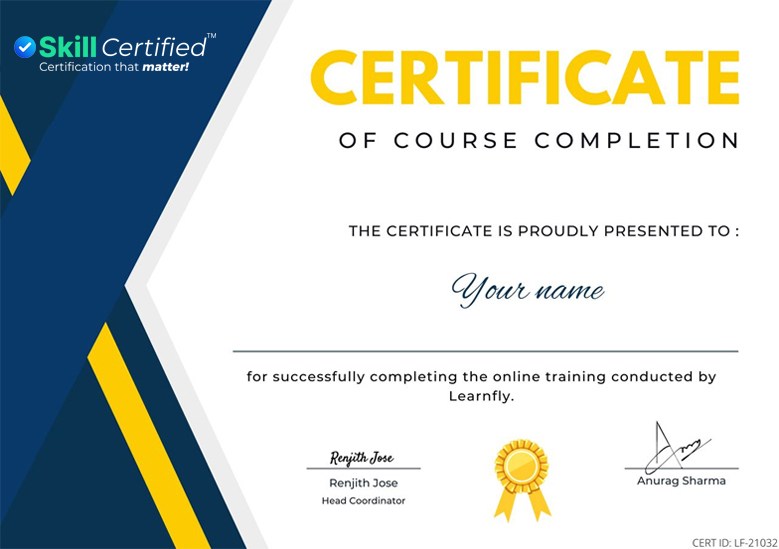December sale is liveEnds in
Get upto 30% discount on trending certification courses. Apply Now
This course training is available on request only. Send us your request with preferred date & Time & our training advisor will get back to you within 24 business hours.
How to manage their Azure resources, including deployment and configuration of virtual machines, virtual networks, storage accounts, and Azure AD that includes implementing and managing hybrid identities.
Learn how cloud resources are managed in Azure through user and group accounts, and how to grant access to Azure AD users, groups, and services using Role-based access control (RBAC).
Learn about the different storage accounts and services as well as basic data replication concepts and available replication schemes.
Introduced to Storage Explorer as a convenient way to work with Azure storage data.
Learn the types of storage and how to work with managed and custom disks.
Azure blob storage is how Azure stores unstructured data in the cloud, and you will work with blobs and blob containers. In addition to blob storage, the course covers Table and Queue storage as storage options for structured data.
Learn how to create and deploy virtual machines in Azure, using the Azure portal, PowerShell, and ARM templates. The course includes instruction on deploying custom images and Linux virtual machines. You will see how to configure the networking and storage components of virtual machines. Deploying highly available virtual machines is critical for planned and unplanned events, and you will learn how to use availability sets to ensure that virtual machine resources are available during downtime.
Learn the monitoring tools and capabilities provided by Azure, including Azure Alerts and Activity Log. In addition to alerts and logs, you will be introduced to Log Analytics as an effective data analytics solution for understanding your system status and health. And perhaps the most exciting thing you will learn is how to use the Azure Resource Manager deployment model to work with resources, resource groups, and ARM templates.
Discover, assess, plan and implement a migration of on-premises resources and infrastructure to Azure.
Learn how to use Azure Migrate to perform the discovery and assessment phase that is critical to a successful migration. Students will also learn how to use Azure Site Recovery for performing the actual migration of workloads to Azure. The course focuses primarily on using ASR on a Hyper-V infrastructure to prepare and complete the migration process.
Learn how to deploy serverless computing features like Azure Functions, Event Grid, and Service Bus. You will learn how Azure Multi-Factor Authentication helps safeguard access to data and applications, helping to meet customer demand for a simple sign-in process. Also, how to use Azure Active Directory Privileged Identity Management to manage, control, and monitor access to Azure resources within your organization.
Manage and maintain the infrastructure for the core web apps and services that developers build and deploy.
Learn how Azure App Service is used as a Platform as a Service (PaaS) offering for deploying cloud apps for web and mobile environments.
Get a glimpse of how to implement advanced networking features like Application Gateway and how to configure load balancing. Learn to integrate on-premises networks with Azure virtual networks and to use Network Watcher to monitor and troubleshoot issues.
Operations are done in parallel and asynchronously. And, how your whole enterprise system must be resilient when failures occur, and just as importantly, how deployments can be automated and predictable. By using the Azure Application Architecture Guide and Azure reference architectures as a basis, you will understand how monitoring and telemetry are critical for gaining insight into the system.
You will dive into the cloud design patterns that are important, such as partitioning workloads where a modular application is divided into functional units that can be integrated into a larger application. In such cases, each module handles a portion of the application's overall functionality and represents a set of related concerns.
Load balancing where the application traffic, or load, is distributed among various endpoints by using algorithms. Load balancers allow multiple instances of your website to be created so they can behave in a predictable manner. In Azure, it is possible to use virtual load balancers, which are hosted in virtual machines, if a company requires a very specific load balancer configuration.
Transient fault handling which helps define the primary differences between developing applications on-premises and in the to handle transient errors. Transient errors are errors that occur due to temporary interruptions in the service or to excess latency.
Discussion of hybrid networking that provides an overview of site-to-site connectivity, point-to-site connectivity, and the combination of the two.
How Azure Service Fabric is a distributed systems platform that makes it easy to package, deploy, and manage scalable and reliable microservices and containers. Service Fabric also addresses the significant challenges in developing and managing cloud native applications. Developers and administrators can avoid complex infrastructure problems and focus on implementing mission-critical, demanding workloads that are scalable, reliable, and manageable. Service Fabric represents the next-generation platform for building and managing these enterprise-class, tier-1, cloud-scale applications running in containers.
Learn how to configure a message-based integration architecture, develop for asynchronous processing, create apps for autoscaling, and better understand Azure Cognitive Services solutions.
Dramatically enhance your learning experience with our Microsoft training exclusives. Receive complimentary access to benefits for 90 days following your course completion. The benefits include, practice labs, indexed class recordings, unlimited course retakes, and digital courseware.
Successful Cloud Solutions Architects begin this role with practical experience with operating systems, virtualization, cloud infrastructure, storage structures, billing, and networking.
 Live Interactive Learning
Live Interactive Learning Lifetime Access
Lifetime Access 24x7 Support
24x7 Support Hands-On Project Based Learning
Hands-On Project Based Learning Industry Recognised Certification
Industry Recognised CertificationGet a e-Certificate of Course Completion after successfully completing your live class with SkillCertified™. Share & showcase your proud achievement with your friends & colleagues. Join a live class today & start learning online from anywhere:
